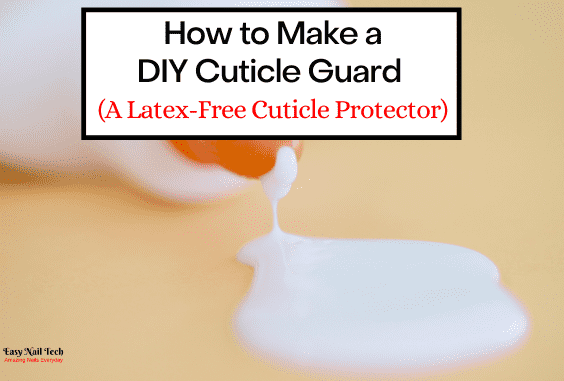2 Simple DIY Cuticle Guard – Latex-Free Cuticle Protector

One of the biggest hassles when doing certain types of nail art is having to clean up your cuticles (the skin around your nails) when you are finished.
And worst yet if you clean up your cuticles incorrectly (the biggest mistake is using too much acetone) you can actually ruin your manicure.
Now by applying a layer of cuticle guard over your cuticles you can make cleaning them up super easy and you won’t have to use any acetone.
So in this article, I am gonna share with you two Simple DIY Cuticle Guard Recipes that you can make from home.
1- Glue Based DIY Cuticle Guard
One of the easiest ways to protect your cuticles is to apply a layer of white paper glue around the cuticle skin of your nails. To do so you need to:
- First, pour out some glue into a container
- Next, using an old nail polish brush take some of the glue and apply it around your nails
- And then leave it to dry, it usually takes 5-6 minutes to dry but you can use a hairdryer or a fan to make it dry faster.
- Once the glue has dried you can start applying your nail art.
- Now to tell if the glue is dry it will become clear.
- Finally, once you have applied your nail art you can use a tweezer to peel away the glue which removes any stray nail polish.
- You can see how it’s done in the video below.
Pros of Using Glue as Cuticle Guard
- Very Effective and Affordable – Using glue is an effective and budget-friendly way to make a cuticle guard without having to spend extra money on a brand name cuticle guard.
- Non-toxic and Very Safe – Most brands of glue are perfectly safe and won’t pose any health risk to you. I recommend using Elmers Glue, you can click here to see it on Amazon.
Or you can get it in most retail store
- Latex-Free – most brands of cuticle guards contain liquid latex which a lot of individuals are allergic to. Now paper glue doesn’t use any latex so you wouldn’t have to worry about allergies.
But if you are worried about using glue, I would advise that you test it out first. You can do so by applying a little glue on your hand and leaving it dry and then peel it away.
Now if your skin remains normal you shouldn’t have anything to worry about but if you see any adverse reaction I would advise not using it on your cuticles.
Cons of Using Glue as Cuticle Guard
The main drawback of using glue as a cuticle guard is that it takes longer to dry and harden.
In comparison to a brand name cuticle guard which dries within 1-2 minutes whilst glue depending on the brand can sometimes take 5-6 minutes to dry completely.
Now if you want a cuticle guard that works really fast I recommend using Pueen Latex Cuticle Guard, you can click here to see the current price on Amazon. It is one of the most popular brands and is the brand that I have used for years.
2- Use Petroleum Jelly as a Cuticle Guard
One of the quickest and easiest ways to DIY a Cuticle Guard is to apply petroleum jelly (Vaseline) on your cuticle skin around your nails before applying your nail art. Citation.
And when you are finished applying your manicure, you can just wipe away the petroleum jelly which will remove most of the nail polish that may have gotten on your cuticles.
You see what happens is that any nail polish that may have gotten onto your cuticle won’t be able to reach the skin since the petroleum jelly acts as a barrier preventing it. Instead, the polish will remain on the jelly which can be easily wiped away.
This method isn’t as effective as using glue or a brand name cuticle guard meaning staining is still possible. But it works faster and would also help to moisturize your cuticles keeping them healthy and strong.
How Does A Cuticle Guard Work
A cuticle guard acts as a barrier or a layer to protect your cuticle skin from getting stained by your nail polish, acrylics, or even glitter.
The cuticle guard layer can then be easily peeled away which removes any unwanted debris without the need for acetone leaving your cuticle skin looking perfect.
You see if you use acetone you can potentially smudge your nail art and dry out your cuticles.
